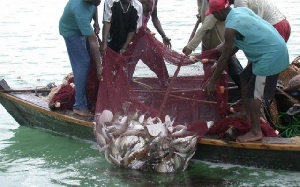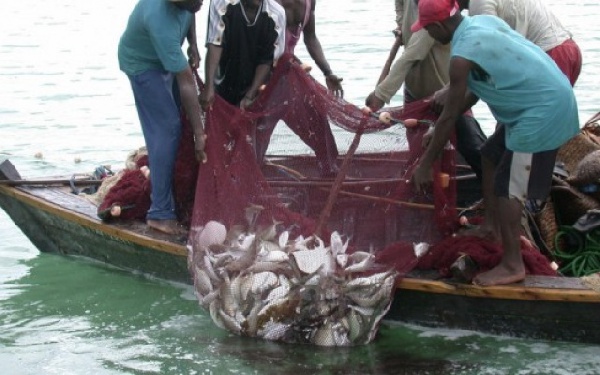 Fishermen pulling back their net after making a catch
Fishermen pulling back their net after making a catch
The Fisheries Commission has said incidents of child, forced labour and human trafficking still linger in the country’s fisheries sector, particularly in remote fishing communities.
The commission said these incidents are on the rise and are prevalent in fishing communities in significant proportions due to increased socio-economic vulnerabilities and, in a way, cultural norms.
Speaking to the B&FT at the launch of Employers’ Code of Practice for Eliminating Child and Forced Labour and Human Trafficking in the country’s fisheries sector, Deputy Executive Director of Fisheries Commission, Dr. Eric Kobbina, said factors including poverty, ignorance, broken homes and high childbirth rates are some leading factors of child labour, forced labour and trafficking.
He said the lack of enforcement of child labour and trafficking laws and the porous nature of national borders are contributing to the high incidents of trafficking and forced labour.
The document, which was launched under the auspices of the Ghana Employers’ Association (GEA) with collaboration of relevant partners – including the National Fisheries Association of Ghana, the International Labour Organisation, among others, seeks to advocate a total eradication of children and forced labour, including trafficking in the country’s fishing space.
Ghana Employers’ Association commits to end child labour in fishing
The Chief Executive of the Ghana Employers’ Association (GEA), Alex Frimpong, stated that the association remains committed to protecting workers’ rights while ensuring the competitiveness and sustainability of business operations in the fishing sector.
“We firmly believe that an industry free from exploitation fosters productivity, economic stability and global competitiveness,” he said.
The code of practice and its action plan, according to the GEA, will reaffirm the sector’s collective commitment to eradicating child labour, forced labour, modern slavery and human trafficking from the fishing sector.
Incidents of child labour and forced labour-related tendencies continue to confront the sector in various ways.
Data supports rising child labour in fishing
Data from the Ministry of Fisheries and Aquaculture Development (MoFAD) indicate that over 1.23 million children – 14.2 percent of the children’s population in Ghana – are in hazardous child labour and child-trafficking situations; and over 50,000 of these children are involved in fishing, with thousands trafficked from as early as age four.
However, MoFAD and its stakeholders currently implement a Policy on Anti-Child Labour and Trafficking in Fisheries as a solution to the menace, which still persists.
By the International Labour Organisation’s (ILO) latest estimates, almost 28 million people globally, children inclusive, are trapped in forced labour.
This figure indicates a rise of approximately 2.7 million since the previous estimate in 2016.
Fishing is an important economic activity in Ghana, and it accounts for five percent of the agricultural gross domestic product (GDP). The sector also accounts for 60 percent of animal protein consumed, and an estimated three million Ghanaians are directly involved in fishing – representing a little over 10 percent of the workforce.
